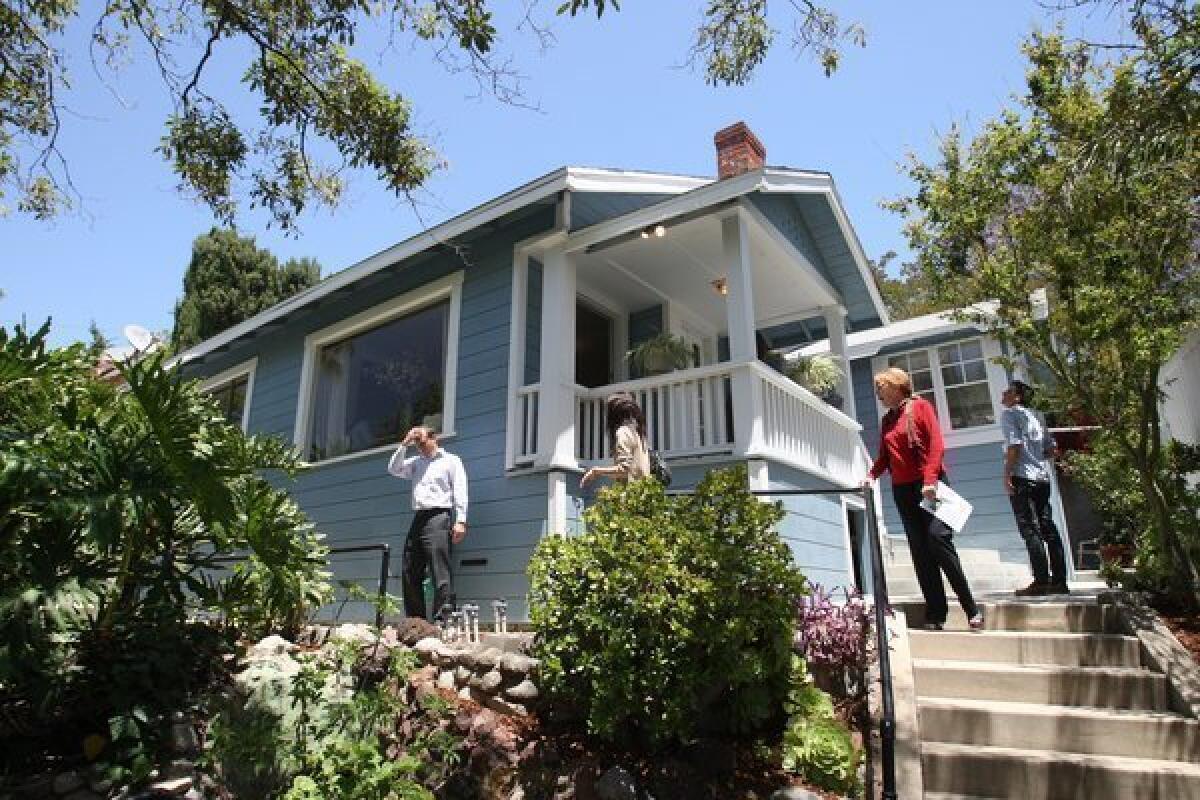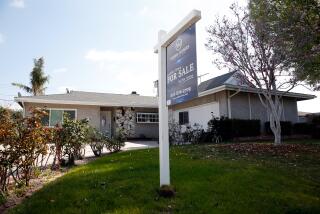Southland median home price in March increases again

The median home price in Southern California rose about $25,000 in March alone to hit $345,500, underscoring the regionâs fast-paced recovery.
That represented an 8% increase from February and a 23.4% jump from a year earlier. It was the eighth consecutive double-digit increase and the highest level for the median since July 2008, according to March numbers reported Wednesday by real estate firm DataQuick.
The robust gains, driven by a low inventory of homes for sale, more âmove upâ purchases and fewer foreclosures, should help solidify a recovery that began last year.
Some analysts have voiced concern about the potential for speculation in fast-gaining markets in Southern California. Many others note that a sharp recovery should be expected, given how far home prices fell during the bust. Donât expect these increases to be quite so sharp, analysts said, particularly as more inventory hits the market. Any increase in interest rates could also cool off the market.
âThose levels of house-price increases cannot be sustained, and will not be sustained, and nobody should make the mistake that we are back in the bubble period,â said Stuart Gabriel, director of UCLAâs Ziman Center for Real Estate. âThe price increases will elicit new supply, and we see evidence of that new supply in the new home market.â
The median price increases are driven not only by home values but also by changes in the types of properties selling. Fewer foreclosure sales in cheaper neighborhoods raise the median, as does a trend of more expensive homes selling in so-called move-up markets.
âItâs remarkable how much the housing scene has changed in a year,â DataQuick President John Walsh said. âWeâre seeing the release of a lot of pent-up demand, especially in the middle- and higher-priced neighborhoods where activity had been sluggish for years.â
Foreclosures accounted for only 13.9% of sales last month, down from 16.2% in February and 31.5% of all sales a year earlier. In February 2009, foreclosure sales peaked at 56.7% of all sales.
Sales in lower-cost areas also fell. The number of homes that sold below $200,000 fell 33.3% compared with a year earlier.
At the same time, sales of homes in pricier neighborhoods have been strong. Sales from $300,000 to $800,000 rose 29.5% over the year. Sales of homes priced more than $800,000 increased 33.4%.
Dick Caley, a Long Beach real estate agent with Coldwell Banker, said a recent bidding war for a home in Signal Hill pushed a house originally listed at about $800,000 to above $1 million.
âThe market is still very much a sellerâs market; we have more buyers than sellers, and the inventory â I would love to have more of it to sell,â he said. âEverything is getting multiple offers, but it has crept from the low, to the middle, to even the high end.â
Despite those increases, Caley said he expects to see sales moderating in coming months.
Houston Smith, an agent with Re/Max Estate Properties in Hermosa Beach, also said that he expected price gains and sales to slow.
âThat market looked like it popped there for a little bit â sales popped, everything kind of popped â and now it looks like it is slowing,â Smith said. âIt could just be that all the people who were waiting just rushed in.â
Southland housing snapshot
Southern California home sales and prices in March and percentage change from a year earlier:
| Los Angeles | 6,962 | +2.8% | $380,000 | +24.2% |
| San Diego | 3,762 | +16.2% | $380,000 | +18.6% |
| Riverside | 3,532 | -6.0% | $245,000 | +22.5% |
| Orange | 3,063 | +7.2% | $505,000 | +26.3% |
| San Bernardino | 2,406 | -4.2% | $190,000 | +26.7% |
| Ventura | 856 | +4.4% | $403,250 | +15.2% |
| Southern California | 20,581 | +3.1% | $345,500 | +23.4% |
Source: DataQuick
Los Angeles Times
Overall, 20,581 new and previously owned houses and condominiums sold in Los Angeles, Riverside, San Diego, Ventura, San Bernardino and Orange counties last month. That was a 29.1% increase over February â a normal seasonal jump â and a 3.1% increase over a year earlier.
The only place where sales slowed was the Inland Empire â in Riverside and San Bernardino counties â dropping 5.3% from the same month a year earlier. Low-priced properties in the area have been snatched up by well-heeled investors, including private equity firms and other major investors.
The number of absentee and cash buyers in March was near record levels throughout Southern California. Absentee buyers bought 30.6% of all homes, while people paying cash bought 34.1% of all homes.
Home flips â buying to sell a short time later at a profit â are also becoming more popular. In March, 6.1% of homes sold had been sold once before in the previous six months. That was down from 6.7% in February, but up from 4% a year earlier.
As prices increase, more people will be tempted to put their properties on the market, potentially increasing supply. And the Federal Reserve will at some point end its campaign to keep mortgage-interest rates low.
âI suspect that eventually you will see some affordability constraints, which should slow down the home sale increases,â said Gerd-Ulf Krueger, principal of HousingEcon.com.
A recent analysis by real estate website Redfin.com showed home prices are rising faster than incomes in Los Angeles, making it more prone to a housing bubble than many other major cities. But many experts and real estate professionals remain unconcerned that a bubble is forming.
Richard Green, director of USCâs Lusk Center for Real Estate, believes prices are bouncing back quickly because the panic of the housing crash made them irrationally low. The increases, he said, are being driven by short supply rather than irrational buyers.
âThat is something to be concerned about, but it doesnât mean there is a bubble,â he said. âIf prices go up another 20% in the next year, then that is starting to get bubbly.â
Times staff writer Andrew Khouri contributed to this report.
More to Read
Inside the business of entertainment
The Wide Shot brings you news, analysis and insights on everything from streaming wars to production â and what it all means for the future.
You may occasionally receive promotional content from the Los Angeles Times.










